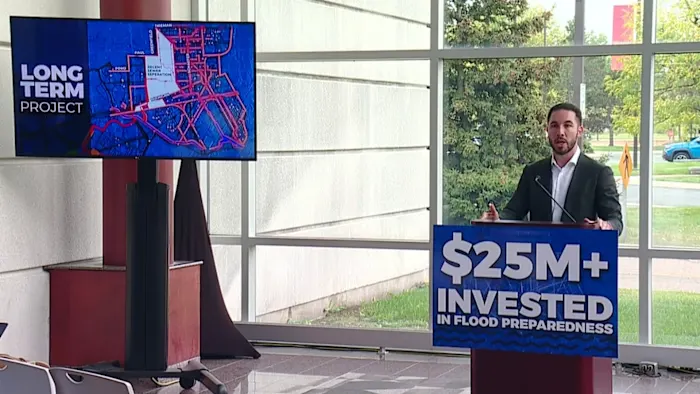
DEARBORN, Mich. – The City of Dearborn is taking steps to make sure the city’s infrastructure can handle increased rainfall without flooding.
During a press conference Thursday, Sept. 25, City Council President Mike Sareini and Mayor Abdullah Hammoud addressed the city’s ongoing flooding challenges, reflecting on past events and outlining current efforts.
Sareini recalled the severe flooding in 2018 and 2021, which caused extensive property damage and eroded public trust. These events prompted a comprehensive, multi-year third-party study to evaluate the city’s flood mitigation needs.
The study found that Dearborn’s combined sewer and stormwater system currently manages about 3.5 inches of rainfall per day, leaving the city vulnerable to heavier storms. Sewer separation was identified as the most cost-effective long-term solution to increase capacity.
Since 2021, the city has invested more than $25 million in flood preparedness and stormwater management, with additional projects planned.
Short-term actions already underway include clearing over 50 logjams along a 2.5-mile stretch of the Rouge River. This effort lowered river levels by more than one foot and increased flow by an estimated 70% during storms.
Dearborn is among the first Michigan cities to implement a comprehensive smart flood monitoring system. This expanded infrastructure enhances flood monitoring capabilities and positions the city as a leader in using advanced technology for urban safety.
Green infrastructure initiatives are also underway. These include converting easements along Moore Circle into stormwater-holding biosites and installing underground stormwater retention systems at Peace Park West. Other efforts involve adding permeable pavements, increasing tree plantings through a free tree program, and expanding Green Schoolyard and rain garden projects.
“Trees are actually one of our greatest tools, which is why we’ve invested more city dollars in trees than ever before, historically,” Hammoud said.
Looking ahead, the city plans to launch a series of large stormwater projects, starting with “Project One / Notre Dame.” This new storm line will serve about 800 acres and significantly increase system capacity. It is the first of five major projects planned for future phases.
Next steps include continuing the design and construction of short-term projects already in progress, finalizing designs for Project One and subsequent stormwater projects, and collaborating with federal partners through the Army Corps study to obtain funding.



